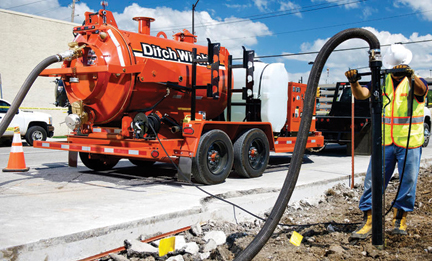Rental Solution
Vacuum Excavators: Powerful Tools for Rental Fleets
A safer way to work around underground utilities
by Jason Proctor
Underground is an increasingly crowded – and risky – place to do business in many communities. Telecommunication cables, natural gas pipes, electrical transmission wires, water mains, irrigation lines and other utilities can pose unseen hazards for anyone who needs to dig.
 |
| Jason Proctor, product manager, Ditch Witch |
Minimizing that risk – and helping to prevent damage to utilities, equipment, the environment and, most importantly, personnel – is a major reason behind the growth of compact, trailer-mounted vacuum excavators in equipment rental stores and equipment dealer fleets.
Vacuum excavators are two machines in one: a “soft” burrowing tool to precisely control excavations, and a powerful, portable vacuum that can quickly clean up a multitude of work sites.
Depending on make and model, a vacuum excavator displaces dirt using either pressurized water or air, which the machine operator directs using a wand. As soil or mud is disrupted, the unit’s vacuum sucks up the spoils and deposits them into an onboard holding tank. Later, they can be used to refill the hole or transported off-site for disposal.
Vacuum excavators have revolutionized potholing, which entails using safe excavation practices to expose an underground utility so workers can see location and depth. Vacuum excavation can expose utilities to confirm their location without the higher risk of damage with traditional hand-digging tools, including blunt-tip shovels, picks and digging bars. It’s also faster. In most soil conditions, a 12-inch-square, 5-foot-deep pothole can be completed in less than 20 minutes, depending on the size of the machine.
A rising number of construction companies, utility contractors and other businesses are renting vacuum excavators because of the safety factor. Utility-damage prevention alone has significantly driven up rentals of Ditch Witch vacuum excavators in the last few years. Equipment-industry forecasters predict continued growth in the next several years, for the same reason.
Case in point: Explosions caused by ruptured natural gas lines in the last five years prompted utility owners and contractors to require that its workers – as well as anyone whose business requires them to dig underground – use vacuum excavators to visibly expose and identify gas lines and other underground utilities before proceeding.
Most U.S. telecom companies also have adopted vacuum excavation as the “best practice” for confirming the location of underground utilities, and require subcontractors to use the machines before installing fiber optic cables.
Oil and Gas Boom Driving Demand
Damage prevention mandates like these are helping drive utilization rates for vacuum excavators in rental fleets. Another major contributor: the boom in oil and gas production across America. Growth in that industry began with the advent of horizontal directional drilling (HDD) in the late 1990s, and it has since expanded exponentially.
HDD allows oil and gas workers to more accurately control the direction that they're drilling deep underground for distant oil and gas formations – even in populated areas. Increasingly, oil and gas rigs are being set up on the outskirts of communities to drill in multiple directions horizontally.
Vacuum excavators are used to support HDD applications that install transmission lines/pipelines that carry the oil from place to place.
Many oil and gas contractors also use vacuum excavators for potholing. That’s because horizontal drilling for miles underground may require tunneling under roads, bridges and railroads easements – all places where buried utilities could be damaged. Vacuum excavation requires little time, which is well worth avoiding a costly and dangerous utility strike.
Equipment rental businesses are offering quick solutions to these companies’ immediate needs.
Because of the relative newness of vacuum excavators in this application, many businesses that support petroleum exploration by installing underground pipelines and/or verifying underground utilities prefer to rent the machines locally.
Beyond the Pothole
The vacuum excavator’s digging capabilities extend well beyond potholing. Telecom contractors frequently use them to create short to medium length excavations to install fiber optic cable. A single worker can easily take the machine’s pressurized water or air hose into small areas where other equipment can’t fit.
Municipal workers and contractors also use vacuum excavators to dig holes for street signs and other poles, and to dig trenches in easements crowded with utilities. Jetting attachments are useful in cleaning out conduit, and sanitary and sewer lines.
Because of their versatility, vacuum excavators also appeal to other rental customers – including small businesses and homeowners. The machines can be used as a powerful, portable vacuum for just about any type of cleanup where a smaller handheld vacuum won’t suffice. Cleaning out flooded basements and parking lot storm sewers are typical uses for residential and small business customers.
With so many uses for vacuum excavators, rental businesses should be versed in the various sizes, features and capabilities of those on the market. Most vacuum excavators in rental stores are compact models that dig with pressurized water and are mounted on trailers that can be pulled by pickup trucks. A good example is the popular Ditch Witch FX20: 27 horsepower, 540 cubic feet per minute (cfm), excavating water pressure to 3,000 pounds per square inch (psi). Five other Ditch Witch vacuum excavators range in size to the powerful FX60: 74 horsepower, 1020 cfm maximum airflow, excavating water pressure to 3,000 psi.
Armed with the right information and the best units to suit their fleet, rental businesses can help customers large and small take advantage of versatile vacuum excavation.










